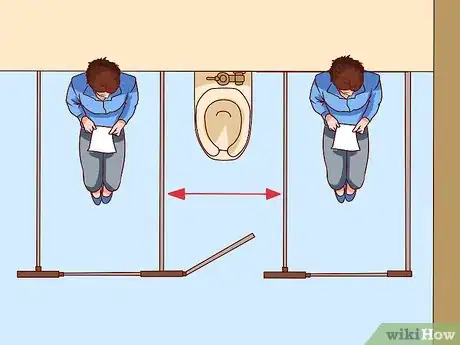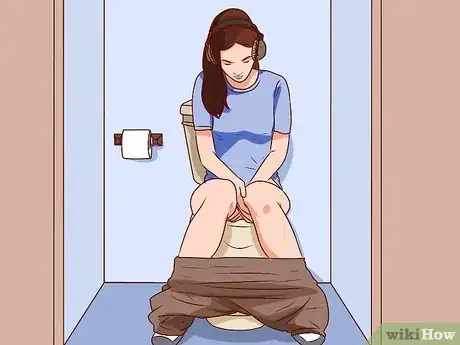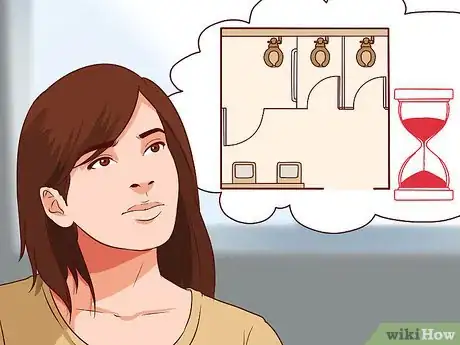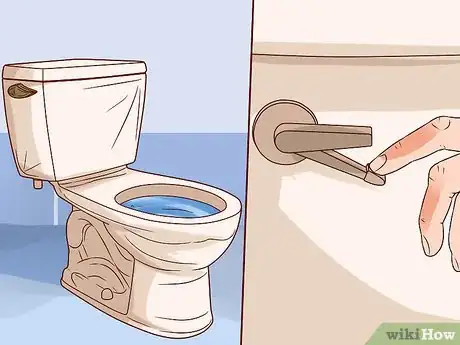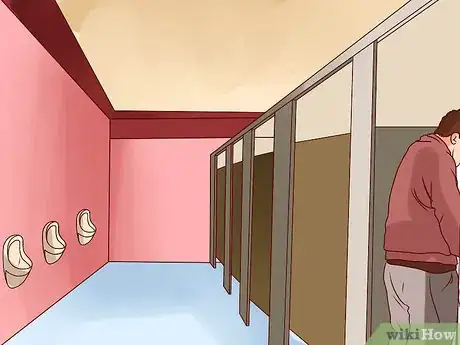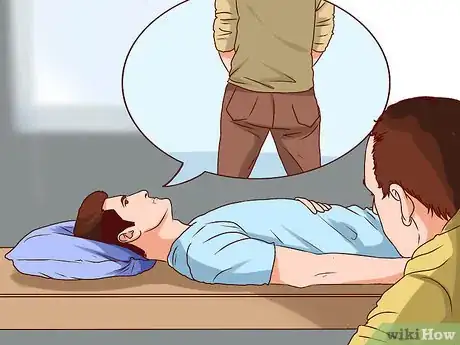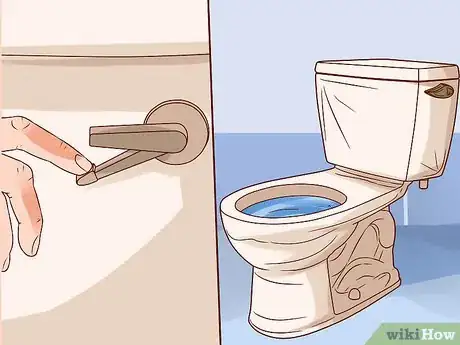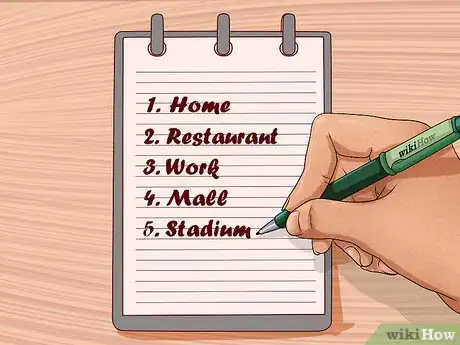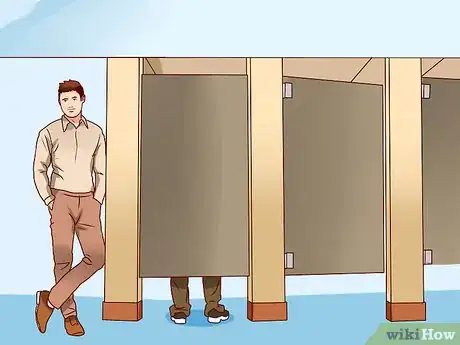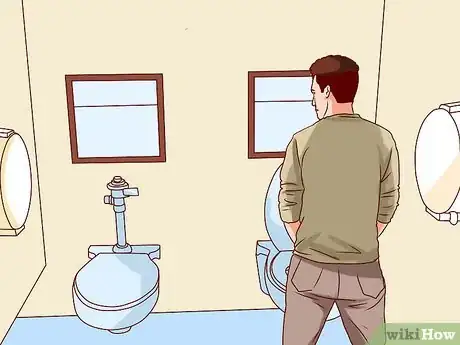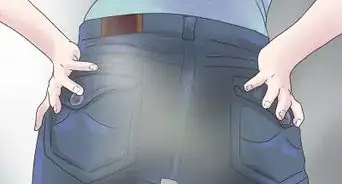This article was co-authored by wikiHow Staff. Our trained team of editors and researchers validate articles for accuracy and comprehensiveness. wikiHow's Content Management Team carefully monitors the work from our editorial staff to ensure that each article is backed by trusted research and meets our high quality standards.
This article has been viewed 390,953 times.
Learn more...
Urinating in front of other people can be embarrassing and uncomfortable. Individuals who have a lot of difficulty urinating when other people are around may have “shy bladder syndrome” or “paruresis.” Paruresis is considered a social phobia like the fear of public speaking. Individuals afflicted by paruresis can experience symptoms on a spectrum of severity — some people only experience paruresis occasionally while others aren’t able to urinate unless they're in their bathroom at home.[1]
Steps
Making Peeing in Front of Others More Comfortable
-
1Create a buffer between yourself and others. If you’re uncomfortable peeing in public one easy way to at least trick yourself into believing you’re alone is to keep an empty stall or urinal between yourself and any other bathroom users.[2]
- If you’re uncomfortable peeing in front of your partner, this may simply mean that you close the door while you're in the bathroom, or wait until your partner is in another part of your home.
-
2Listen to your iPod. Sometimes the thing that bothers people most is the sound of peeing. But if you aren’t able to hear your own peeing, you might not be so embarrassed. When in a public washroom, put your headphones on and listen to some music. Turn it up loud enough so you can’t hear anything else going on in the washroom.[3]
- Consider putting a radio or Bluetooth speaker in the bathroom at home. Make it a habit of turning it on whenever you go into the bathroom. The music will help distract you from the sound of your peeing and possibly prevent your partner from hearing it.
Advertisement -
3Stop talking. When some people walk into a public washroom they sometimes continue to have conversations. This tends to continue more often when men or boys pee at urinals. If it helps, remember that peeing is totally natural, and urinals are very efficient. Or if you’d prefer to do your business in private, use a stall instead of a urinal.[4]
- The opposite might be possible if you’re at home or at a urinal with your father/son/brother/etc. Continuing your conversation while you go to the bathroom might make the whole process seem more comfortable and ‘normal’.
-
4Wait until you’re alone. If you’re at work or a restaurant and can wait to go to the washroom, watch the bathroom door until you’re certain no one is in there and then go to the washroom. Even if it’s a public washroom you might feel more comfortable if no one else is in there. If necessary, walk out of the washroom and come back later if it’s occupied.[5]
- If you don’t want to wait and come back later, take your time adjusting your clothes or make-up in the mirror, or washing your hands, until the washroom is empty.
-
5Plan ahead. Many large event locations (e.g. arenas, stadiums, conference centres, malls, etc.) have maps of their buildings online that include the location of the washrooms. And some cities even have maps of all public washrooms available in city buildings, parks, etc. Before going out, research where the public washrooms are so you can be proactive about using them rather than waiting for it to be an emergency.[6]
- You can also keep track of the public washrooms you use and always go back to your favourites. Some washrooms that are easier to use are those that have partitions all the way to the floor, or are single person washrooms.
-
6Flush the toilet. While not the most environmentally-friendly option, if you’re nervous about the sound of your peeing in a public washroom, flush the toilet while you’re going. The sound of the flush will usually drown out the sound of the peeing.[7]
- Alternatively, wait until someone else has flushed a toilet or is running a tap to wash their hands.
Determining If You Have Paruresis
-
1Determine if you have paruresis. Individuals with paruresis tend to have shy personalities and are sensitive and fearful of being judged and criticized by others. Those with severe cases of paruresis may have one or more of the following symptoms:[8]
- Needing to have complete privacy when going to the bathroom.
- Being fearful that other people may hear the sound of urine hitting the water in the toilet.
- Being fearful that other people may be able to smell the urine.
- Having negative thoughts while attempting to pee (e.g. I’m such a moron, I’m never going to be able to go pee here.).
- Not being able to pee in public washrooms, washrooms at other people’s homes or washrooms at work.
- Not being able to pee at home if someone else is visiting or waiting outside the bathroom.
- Being anxious at the thought of having to go to the bathroom.
- Not wanting to drink too much liquid for fear they’ll have to use the bathroom.
- Avoiding travel and events outside the home in case they have to use the bathroom.
-
2Know that paruresis is not a physical problem. The inability to pee in front of other people or when other people are around, is not a physical problem. There is nothing wrong with your kidneys, bladder or urinary tract. Unfortunately paruresis is caused by anxiety which tenses the muscles of the body, including the ‘urinary sphincter’ which prevents urine from being able to exit the body.[9]
- The problem can enter a vicious circle as the fact that you are not able to pee then makes you more anxious, which makes it harder to pee, and so on.
- It is possible that one specific event in your past caused the problem.
-
3Make an appointment with your family doctor. While paruresis is not a physical problem, you may have physical problems that are making it worse. In order to ensure you don’t have any of these other physical problems, it’s best to talk to your doctor and have those other problems investigated.[10]
- An example of a physical problem that may make your paruresis is prostatitis, which can affect men.
-
4Use medical-based solutions from your doctor. While paruresis is not a physical problem, there are some medical options your doctor may suggest. Your doctor may prescribe anti-anxiety medications, anti-depressants or tranquilizers to help eliminate or reduce the anxiety you feel when trying to pee when others are around.[11]
- Note that these drugs are not a cure for paruresis, so it is still helpful to obtain other types of help to eliminate the problem completely so you can eventually stop taking these medications.
- In very severe cases your doctor may suggest self-catheterization. This is where a catheter (a very slender tube) is inserted into the urethra and into the bladder. Urine can then drain from the bladder without the need to relax the urinary sphincter.
Treating Your Paruresis
-
1Become a member of the IPA. The International Paruresis Association (IPA) is a non-profit organization (based in the United States) that provides support and raises public awareness about paruresis. They offer free membership to anyone who is affected by paruresis, which includes the ability to attend their support group and workshops.[12]
- Check out the IPA website at http://paruresis.org.
-
2Join a support group. The IPA provides a list of support groups online at https://paruresis.org/support-groups/. Support groups are available in many countries around the world, and in multiple locations in Canada and the United States. Contact the support group leader for more information on meeting times and locations.[13]
-
3Seek therapy with a psychologist. There are many ways to find a psychologist to help you with paruresis. The IPA’s website has a list of psychologists who specialize in the treatment of paruresis at http://paruresis.org/sbc-therapists/. You can also ask your family doctor for a referral or recommendation. Or you can search for a psychologist via your local medical listings or psychological association.
- When seeking the assistance of a psychologist, make sure you ask if they have experience treating paruresis before you start therapy.
-
4Work through cognitive behaviour therapy. Cognitive behaviour therapy is therapy completed with a psychologist that helps you alter how you think and feel about urination and public washrooms.[14]
-
5Create other noises while going to the bathroom. Because one of the anxieties associated with paruresis is the noise urine makes when it hits the toilet and/or water, one possible method to help overcome the anxiety is to create other sounds in the bathroom while you’re trying to pee. You can do this by turning on a faucet, flushing the toilet, listening to music, or whatever else might work for you.[15]
Going Through Graduated Exposure Therapy
-
1Enlist the help of a psychologist. While you could probably carry out these instructions on your own, it is also helpful to have a psychologist help you through the process. They’ll be able to help you plan the therapy, pick a partner that can help you and discuss the outcomes of each try.[16]
-
2Create a list of bathrooms from easiest to hardest. To start your therapy, you need to make a list of a variety of bathroom locations. These locations need to be everything from very easy to very hard locations for you to go pee. In addition to making the list, rank the locations from easiest to hardest.[17]
-
3Select a ‘pee partner’ to help you. Because the main problem with paruresis is peeing in front of other people, you will need to enlist the help of a trusted family member or friend to help you overcome the problem.[18]
-
4Start with your home bathroom. You most likely consider your home bathroom your easiest location to pee. Since you’re comfortable with this bathroom, the only thing to be added is another human being — your ‘pee partner.'[19]
- Start by going pee in your home bathroom with your pee partner somewhat nearby. Pee for only a few seconds and then stop.
- Wait a few minutes and go back to the bathroom. This time have your pee partner move a little closer to you. Again, pee for a few seconds and then stop.
- Continue this process with your pee partner moving closer and closer to you.
- This process may take several sessions before you’re comfortable peeing in front of your pee partner.
-
5Make noise while your pee. Throughout the process of peeing in your own home with your pee partner, purposely make noise while you’re peeing. The types of noises you want to make are the types that embarrass you when you’re in a public bathroom. For example, if you don’t like to hear the sound of your pee hitting the side of the toilet or the water, purposely make these types of noises while you pee.[20]
- By purposely making these noises you’ll start to get used to them and they’ll become less embarrassing. You’re essentially trying to desensitize yourself from these noises so you don’t think about them when you’re peeing.
-
6Select the next bathroom location on your list. Once you’re comfortable peeing at home with your pee partner and with making a lot of noise, it’s time to move to the next place on your list. The next bathroom on your list might be a quiet public washroom, or maybe the bathroom at a friend’s house.[21]
- Repeat the same process you used at home with your pee partner. Start by having them stand outside the door to the washroom and move gradually closer to where the toilet is.
- Once you become comfortable with a specific location on your list, move to the next location and repeat the process.
- Eventually you’ll reach the hardest location on your list and you’ll find you’re able to pee in a crowded, noisy public washroom.
- You may need to have a practice session 3-4 times a week in order to make the process effective. You should see excellent improvement after 12 sessions if you are consistent.
-
7Drink lots of water before each session. In order to make each practice session more realistic, and to ensure you actually have to go to the bathroom, drink enough liquids so your bladder is full. Do this on purpose before each practice session with your pee partner.[22]
Using the Breath-Holding Technique
-
1Practice holding your breath at home. The breath-holding technique temporarily increases the amount of carbon dioxide in your blood which is suppose to help with relaxation and reduce anxiety. Before using this technique while peeing, practice holding your breath.[23]
- Start by holding your breath for 10 seconds and seeing how you feel.
- Increase the length you hold your breath by 5-10 seconds at a time. Always stop and assess how you’ve reacted to holding your breath. If you don’t feel well after holding your breath — stop — this technique may not be right for you.
- Try holding your breath in different locations so you get use to the technique.
- Once you can hold your breath for 45 seconds, try using the technique in a real bathroom situation.
-
2Start somewhere you feel comfortable. This comfortable bathroom might be at home or in an empty public bathroom.[24]
- Stand or sit in the bathroom as you want and breathe normally.
- On one of your exhales, stop exhaling about 75% of the way through so you do not empty your lungs.
- Hold your breath for 45 seconds. Hold your nose closed if you have to.
- After 45 seconds you should be able to start peeing.
- You may need to perform the exhale technique a second time if you stop peeing midstream.
-
3Practice. This technique only works if you continue to practice in various situations and locations. You may find yourself altering the technique slightly so that it works personally for you — for example, you might decide to start holding your breath as you walk into the bathroom. [25]
Community Q&A
-
QuestionWhat can cause fear of using public bathrooms?
 Community AnswerYou may find the public bathroom super dirty, or you might find people peeking.
Community AnswerYou may find the public bathroom super dirty, or you might find people peeking. -
QuestionWhat if my friend wants to look at me while I pee?
 Community AnswerYou are entitled to privacy and if you feel uncomfortable, tell your friend to back off.
Community AnswerYou are entitled to privacy and if you feel uncomfortable, tell your friend to back off. -
QuestionHow can I get the initial flow of urine going when I have to go in front of a nurse at a clinic every month for a urinalysis?
 Community AnswerMaybe you don't. Maybe they will let you pee in something and give it to her. If not, give it time. Once you do it enough, you will eventually get used to it. Just be sure to drink a lot so you really have to go.
Community AnswerMaybe you don't. Maybe they will let you pee in something and give it to her. If not, give it time. Once you do it enough, you will eventually get used to it. Just be sure to drink a lot so you really have to go.
References
- ↑ https://www.betterhealth.vic.gov.au/health/conditionsandtreatments/shy-bladder-syndrome
- ↑ https://www.theatlantic.com/health/archive/2014/04/the-private-lives-of-public-bathrooms/360497/
- ↑ https://www.theatlantic.com/health/archive/2014/04/the-private-lives-of-public-bathrooms/360497/
- ↑ https://www.theatlantic.com/health/archive/2014/04/the-private-lives-of-public-bathrooms/360497/
- ↑ https://www.theatlantic.com/health/archive/2014/04/the-private-lives-of-public-bathrooms/360497/
- ↑ https://www.theatlantic.com/health/archive/2014/04/the-private-lives-of-public-bathrooms/360497/
- ↑ https://www.theatlantic.com/health/archive/2014/04/the-private-lives-of-public-bathrooms/360497/
- ↑ https://www.betterhealth.vic.gov.au/health/conditionsandtreatments/shy-bladder-syndrome
- ↑ https://www.betterhealth.vic.gov.au/health/conditionsandtreatments/shy-bladder-syndrome
- ↑ https://www.betterhealth.vic.gov.au/health/conditionsandtreatments/shy-bladder-syndrome
- ↑ https://www.betterhealth.vic.gov.au/health/conditionsandtreatments/shy-bladder-syndrome
- ↑ http://paruresis.org
- ↑ https://paruresis.org/support-groups/
- ↑ http://www.gracepointwellness.org/1-anxiety-disorders/article/30679-do-you-have-a-shy-bladder-updated
- ↑ http://www.gracepointwellness.org/1-anxiety-disorders/article/30679-do-you-have-a-shy-bladder-updated
- ↑ https://www.betterhealth.vic.gov.au/health/conditionsandtreatments/shy-bladder-syndrome
- ↑ https://www.betterhealth.vic.gov.au/health/conditionsandtreatments/shy-bladder-syndrome
- ↑ https://www.betterhealth.vic.gov.au/health/conditionsandtreatments/shy-bladder-syndrome
- ↑ https://www.betterhealth.vic.gov.au/health/conditionsandtreatments/shy-bladder-syndrome
- ↑ https://www.betterhealth.vic.gov.au/health/conditionsandtreatments/shy-bladder-syndrome
- ↑ https://www.betterhealth.vic.gov.au/health/conditionsandtreatments/shy-bladder-syndrome
- ↑ https://www.betterhealth.vic.gov.au/health/conditionsandtreatments/shy-bladder-syndrome
- ↑ http://paruresis.org/breath-hold/
- ↑ http://paruresis.org/breath-hold/
- ↑ http://paruresis.org/breath-hold/
